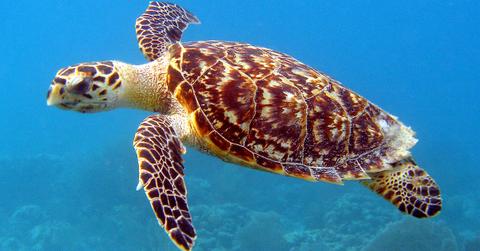More Than 300 Endangered Turtles Hatch On The Beaches Of Singapore
The hawksbill turtle had an excellent month, as hundreds of hatchlings made their way into the Pacific Ocean.
Updated Oct. 4 2018, 11:22 a.m. ET
The hawksbill turtle is a mid-sized sea dweller who likes coral reefs and rocky areas. Although it takes its name from its “hawk-like” beak, its shell is also distinctive, featuring splotches of yellow, orange, and muddy red. The hawksbill is a omnivore that dines primarily on sponges, plus the occasional jellyfish or sea urchin.
But the most important fact about this turtle is that it’s endangered — and has been since 1970.
That’s why conservationists are cheering the recent hatchings on the beaches of Singapore. Over the course of September, more than 300 hawksbill turtles hatched on the Singapore shores and waddled into the sea, providing a welcome population boost to this struggling species.
The baby turtles hatched on three Singapore beaches, according to the National Parks Board. One nest sprang up on the east coast of the mainland, while another appeared on the island of Pulau Satumu. But more than 100 of the hatchlings came from Sentosa Island, a popular tourist getaway.
Parks officials protected the hatchlings on Sentosa Island with a barrier designed to keep preying lizards and crabs out. It was built in July after they discovered the nest. The successful hatching was the fourth time in 22 years that eggs of endangered turtles have hatched on Sentosa Island beaches.
The International Union for Conservation of Nature (IUCN) bumped the hawksbills up from “endangered” to “critically endangered” in 1996, and that’s due to a number of factors. Habitat loss over pollution and coastal development is one of them, while fishing nets and hooks that accidentally trap and drown the turtles are another. But humans also target the hawksbill for food and grooming products.
Its shell is prized for combs, hairpins, and jewelry as well as an ingredient in a “jelly dessert.” (The shell is crushed into a powder for this delicacy.) Hawksbill limbs are also used in turtle soup.
As the World Wildlife Fund explains, hawksbill turtles are important since they promote health coral reefs. The turtles do this by eating sponges off the reef, which gives reef fish better access to feed.
Hawksbills also bring visitors to the so-called Coral Triangle of Indonesia, Malaysia, Papua New Guinea, Timor Leste, the Philippines, and the Solomon Islands. Through this boost in tourism, the hawksbill turtle provides a significant revenue stream to these nations.
The hawksbill’s importance in the ecosystem makes the hatchling news even happier. With any luck, the coming months will see more nests — and more hawksbill turtles making it into the ocean.
